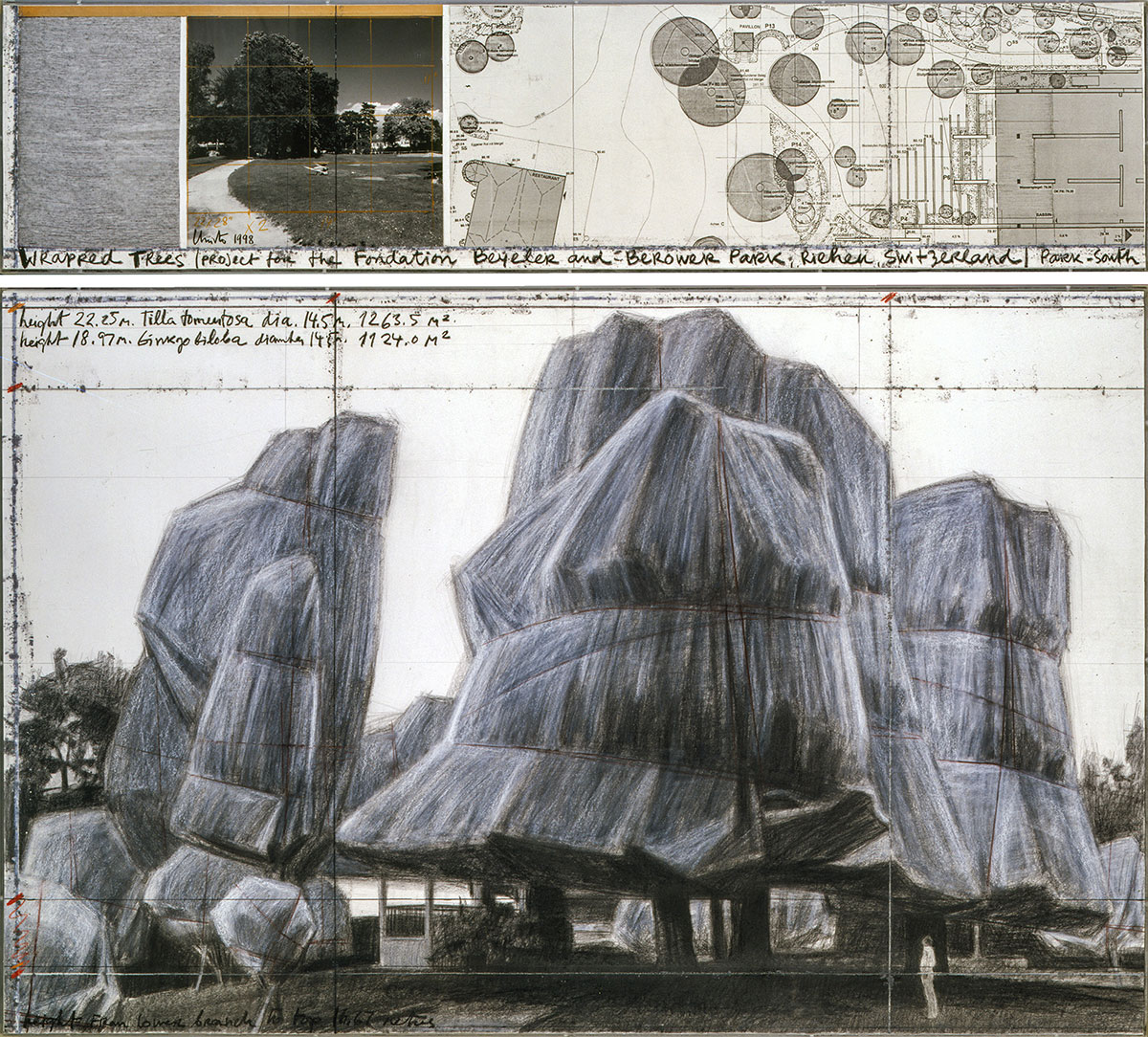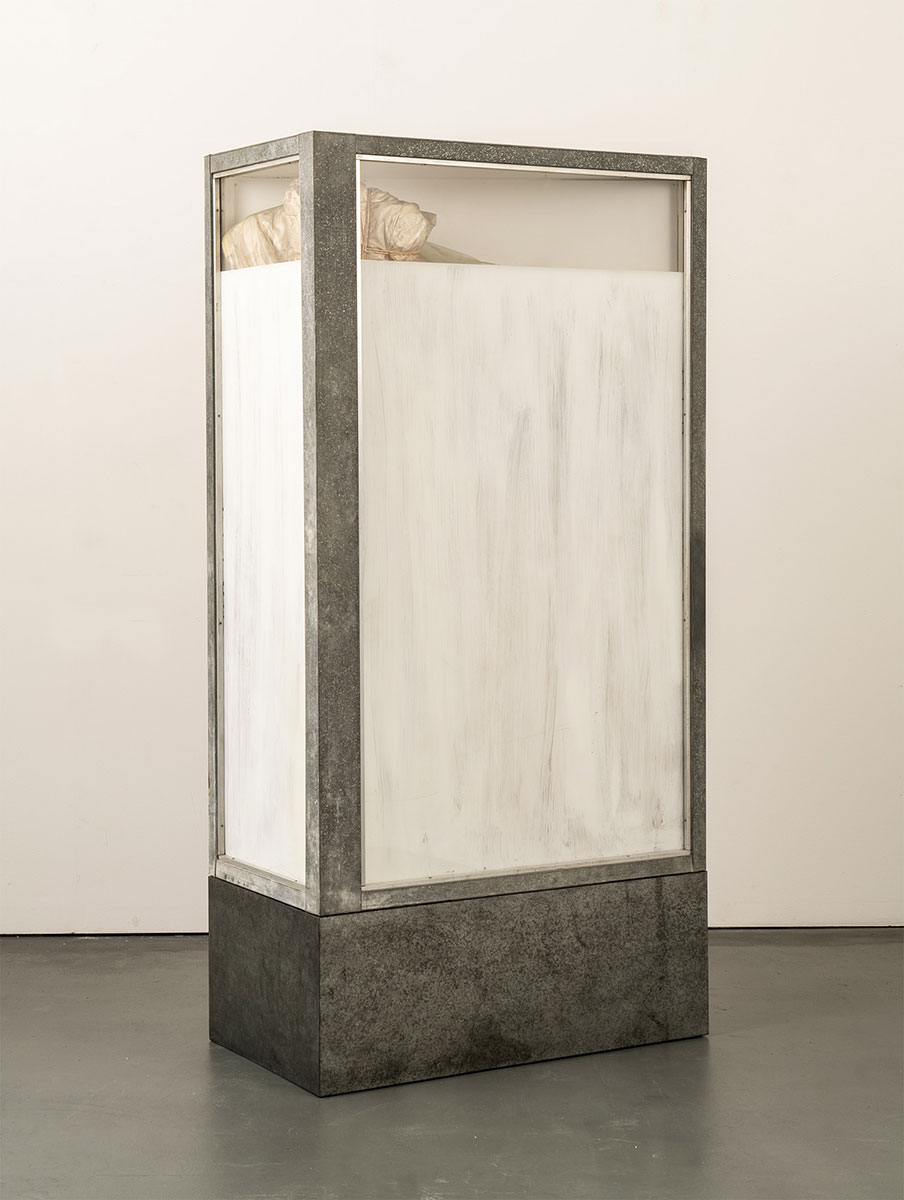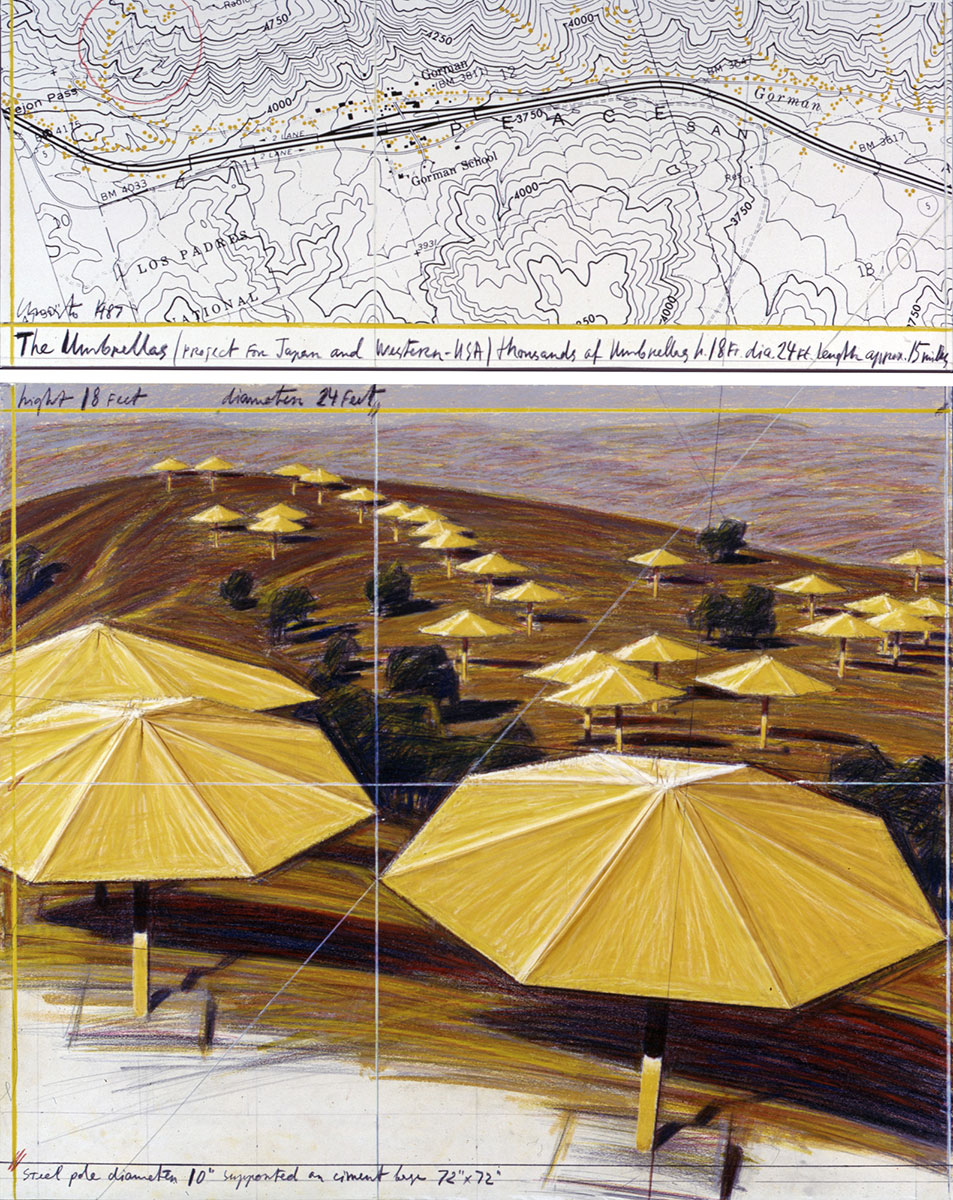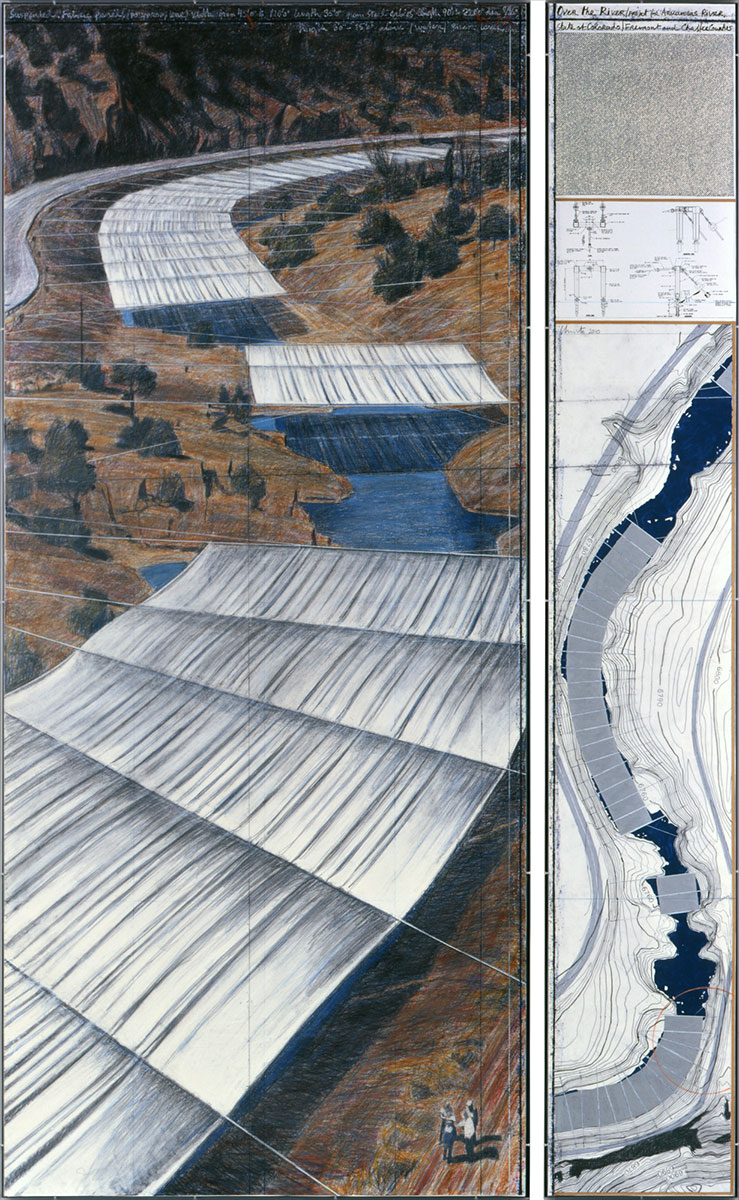ART CITIES: Basel-Christo
 Christo and Jeanne-Claude worked together since their first outdoor temporary work of art: Stacked Oil Barrels and Dockside Packages, Cologne Harbor, Germany, 1961. Before he escaped to the West, Christo studied painting, sculpture, architecture, and decorative arts at the National Academy of Art in Sofia for four years. All early series, such as “Wrapped Cans”, “Wrapped Oil Barrels”, “Packages”, “Wrapped Objects”, and “Store Fronts”, as well as all preparatory drawings, collages, and scale models are works by Christo only. All public projects and indoor installations, both realized and unrealized, are collaborative works by Christo and Jeanne-Claude.
Christo and Jeanne-Claude worked together since their first outdoor temporary work of art: Stacked Oil Barrels and Dockside Packages, Cologne Harbor, Germany, 1961. Before he escaped to the West, Christo studied painting, sculpture, architecture, and decorative arts at the National Academy of Art in Sofia for four years. All early series, such as “Wrapped Cans”, “Wrapped Oil Barrels”, “Packages”, “Wrapped Objects”, and “Store Fronts”, as well as all preparatory drawings, collages, and scale models are works by Christo only. All public projects and indoor installations, both realized and unrealized, are collaborative works by Christo and Jeanne-Claude.
By Dimitris Lempesis
Photo: Gagosian Archive
Christo’s (Christo Vladimirov Javacheff) early education in Soviet Socialist Realism, and his experience fleeing his home as a refugee of political revolution, informed his career’s numerous forays into real-world politics as a primary subject and source of his artmaking. His 35-year collaboration with his wife and fellow artist, Jeanne-Claude, and the large-scale installation works they co-authored, stand out as some of the greatest achievements in early site-specific art. Christo and Jeanne-Claude effectively redefined the relationship between art and public space, expanding the possibilities of scale and transforming familiar landscapes. Often requiring extensive planning and negotiation, these self-funded projects existed only for brief periods, after which their materials were repurposed or recycled, and the sites restored to their original state. The exhibition “Selected Works” in Basel shows sculptures and works of paper by Christo marks the twenty-fifth anniversary of Christo and Jeanne-Claude’s last project in the city in 1998, when they wrapped 178 trees around the Fondation Beyeler in 55,000 square meters of woven polyester fabric. With his “Show Cases”, created in 1963, Christo’s art almost imperceptibly underwent a decisive change. For this work, he bought small glass display cases and medicine cabinets at flea markets and altered their function in absurd ways by covering the inside of their panes with fabric or by pasting paper over them. Nevertheless, even the “Show Cases” can still be interpreted as free-standing sculptures. Their crucial feature, however, was no longer the exterior or the outer shape, but what happened inside, what could or rather could not be seen in their interior. In a reversal of his previous works, the wrapping was basically turned inward. Christo in a sense confronted the viewer of these pieces with the predicament of an unsatisfied voyeurism. He additionally perverted this position in several instances by illuminating the showcases with a light bulb or by conveying the impression of sumptuous decadence, which he achieved by lining the inside with satin or silk or providing occasional glimpses of ostensibly precious jewelry. In 1964, Christo and Jeanne-Claude moved to New York, where Christo transferred the underlying idea of the “Show Cases” to an architectural level with his “Show Windows” and “Store Fronts”. The exhibition features the early sculptures “Store Front, Project” (1964) and “Store Front Corner” (1965), in which Christo made use of salvaged architectural elements resembling shop windows, lining their glass panels with paper or fabric to obstruct the view inside. Complementing these works in Basel is “Show Case (Vitrine)”, a related sculpture from 1963 that employs a tall painted metal vitrine on casters, its interior similarly veiled by hanging white fabric and illuminated by electric light. Preceding the artists’ public projects, these foundational works find Christo already responding creatively to the everyday built environment. Also on view are several studies for Christo and Jeanne-Claude’s renowned site-specific artworks. Featuring detailed original drawings in charcoal, enamel, pastel, pencil, and wax crayon, these highly evocative works often incorporate additional elements such as photographs, fabric samples, handwritten notes, and topographic maps to convey a range of technical information, thereby combining preparatory, documentary, and expressive functions. Several of the examples on display have been featured in major museum exhibitions.
Works on paper include “Wrapped Reichstag (Project for Berlin)” (1987): After a struggle spanning the seventies, eighties and nineties, the wrapping of the Reichstag was completed on June 24, 1995 by a work force of 90 professional climbers and 120 installation workers. The Reichstag remained wrapped for 14 days and all materials were recycled. 100,000 square meters of thick woven polypropylene fabric with an aluminum surface and 15,6 kilometers of blue polypropylene rope, diameter 3.2 cm, were used for the wrapping of the Reichstag. The façades, the towers and the roof were covered by 70 tailor-made fabric panels, twice as much fabric as the surface of the building. The work of art was entirely financed by the artists, as have all their projects, through the sale of preparatory studies, drawings, collages, scale models as well as early works and original lithographs. The artists did not accept sponsorship of any kind. The “Wrapped Reichstag” represents not only 24 years of efforts in the lives of the artists but also years of team work by its leading members Michael S. Cullen, Wolfgang and Sylvia Volz, and Roland Specker. Two drawings titled “Running Fence (Project for Sonoma County and Marin County, State of California)”, one from 1974, the other from 1976—the latter pair representing a temporary project on which Larry Gagosian worked as a construction assistant in 1976. The project was a 5.5 meters high, 39.4 kilometers long, extending east-west near Freeway 101, north of San Francisco, on the private properties of 59 ranchers, following the rolling hills and dropping down to the Pacific Ocean at Bodega Bay. The “Running Fence” was completed on September 10, 1976. The art project consisted of 42 months of collaborative efforts, the ranchers’ participation, eighteen public hearings, three sessions at the Superior Courts of California, the drafting of a 450-page Environmental Impact Report and the temporary use of the hills, the sky and the ocean. All expenses for the temporary work of art were paid by Christo and Jeanne-Claude through the sale of studies, preparatory drawings and collages, scale models and original lithographs. The artists did not accept sponsorship of any kind.“Running Fence” was made of 200,000 square meters (2.15 million square feet) of heavy woven white nylon fabric, hung from a steel cable strung between 2,050 steel poles (each 6.4 meters, 8.9 centimeters in diameter) embedded 91 centimeters into the ground, using no concrete and braced laterally with guy wires (145 kilometers of steel cable) and 14,000 earth anchors. The top and bottom edges of the 2,050 fabric panels were secured to the upper and lower cables by 350,000 hooks. All parts of the project’s structure were designed for complete removal and no visible evidence remains on the hills of Sonoma and Marin Counties. “The Floating Piers (Project for Lake lseo, Italy)”, a large drawing from 2015, plots one of Christo’s final public undertakings, a 3-kilometer walkway that attracted more than 1.2 million visitors over its sixteen-day run in 2016. Italy’s Lake Iseo was reimagined. 100,000 square meters of shimmering yellow fabric, carried by a modular floating dock system of 220,000 high-density polyethylene cubes, undulated with the movement of the waves as “The Floating Piers” rose just above the surface of the water. Visitors were able to experience the work of art by walking on it from Sulzano to Monte Isola and to the island of San Paolo, which was framed by “The Floating Piers”. The mountains surrounding the lake offered a bird’s-eye view of the project, exposing unnoticed angles and altering perspectives. Lake Iseo is located 100 kilometers east of Milan and 200 kilometers west of Venice. “Like all our projects, The Floating Piers was absolutely free and open to the public,” said Christo. “There were no tickets, no openings, no reservations and no owners. “The Floating Piers” were an extension of the street and belonged to everyone”. A 3-kilometer-long walkway was created as “The Floating Piers” extended across the water of Lake Iseo. The piers were 16 meters wide and approximately 35 centimeters high with sloping sides. The fabric continued along 2.5 kilometers of pedestrian streets in Sulzano and Peschiera Maraglio.
Photo: Christo, Wrapped Trees (Project for the Fondation Beyeler and Berower Park, Riehen, Switzerland), 1998, Graphite, charcoal, pastel, wax crayon, photograph by Wolfgang Volz, map, fabric sample, and kraft paper, on paper, in 2 parts, Top: 15 x 65 inches (38 x 165 cm), Bottom: 42 x 65 inches (106.6 x 165 cm), © Christo and Jeanne-Claude Foundation, Photo: Wolfgang Volz, Courtesy Christo and Jeanne-Claude Foundation and Gagosian
Info: Gagosian Gallery, Rheinsprung 1, Basel, Switzerland, Duration: 25/8-28/10/2023, Days & Hours: Tue-Sat 10-18:00, https://gagosian.com



